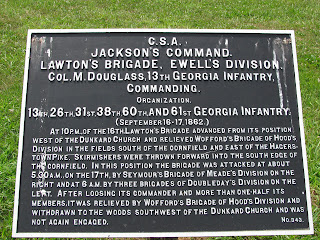I realize that I am a day late with this post but must say that after recovering from what proved to be a great weekend at Harpers Ferry and Antietam, I am truly glad to say that I was a part of it all! When I first became interested in the Civil War in the spring of 2002, never did I imagine that I would participate in the events commemorating the 150th Anniversary of the Battle of Antietam, a battle that changed the course of the war and changed the nation forever.
Briefly, I took part in the living history programs at Harpers Ferry all weekend, including a very touching moment at the site of the pontoon bridge over the Potomac River where 1,500 Union cavalrymen escaped Jackson's Confederates at Harpers Ferry 150 years to the minute as the escape was getting underway (more on that in an upcoming post). During the 150th Anniversary of the bloodiest single day in American history, I participated in the all day battlefield hike, which nearly 600 people attended (again, more on that in a later post). Great job and thank you to everyone at both parks for making the weekend one of the most memorable of my life.
Tuesday, September 18, 2012
Tuesday, August 21, 2012
Alexander Lawton's Brigade (CS)
Alexander Lawton’s Brigade
Commanded by Col. Marcellus Douglass (13th Georgia Infantry)
Ewell’s Division, Jackson’s Command
13th Georgia Infantry
361 men commanded by Capt. D.A. Kidd
26th Georgia Infantry
188 men commanded by Col. Edmund N. Atkinson
31st Georgia Infantry
145 men commanded by Lieut. Col. John Terrell Crowder
38th Georgia Infantry
123 men commanded by Capt. William Henry Battey
60th Georgia Infantry
154 men commanded by Maj. Waters Burras Jones
61st Georgia Infantry
242 men commanded by Col. John Hill Lamar
 |
| Lawton's Brigade War Department Tablet located on the south side of Cornfield Ave. |
Thursday, June 28, 2012
Truman Seymour's Brigade (US): Part 2 (September 17, 1862)
“… The men slept on their arms, ready at a moment’s notice to repel an attack. The gray dawn at last appeared, and every man nerved himself for the conflict. The death-like stillness was at length broken, … and the sharp report of musketry soon marked the commencement of this fierce battle.” That is how Samuel P. Bates, author of History of the Pennsylvania Volunteers, 1861-1865 described the opening of the Battle of Antietam on the morning of September 17, 1862. The troops that “marked the commencement” of the battle were the Pennsylvanians of Truman Seymour’s Brigade, who were bivouacked in the East Woods after their fight with Confederate forces on the previous evening (see http://antietambrigades.blogspot.com/2012/06/truman-seymours-brigade-us-part-1.html).
Tuesday, June 19, 2012
Truman Seymour's Brigade (US): Part 1 (Septemner 16, 1862)
Truman Seymour’s Brigade
1st Brigade, 3rd Division, I Corps
1st Pennsylvania Reserves (30th Infantry)
167 men commanded by Colonel R. Biddle Roberts
2nd Pennsylvania Reserves (31st Infantry)
171 men commanded by Captain James N. Byrnes
5th Pennsylvania Reserves (34th Infantry)
100 men commanded by Colonel Joseph W. Fisher
6th Pennsylvania Reserves (35th Infantry)
250 men commanded by Colonel William Sinclair
13th Pennsylvania Reserves (1st Rifles) (42nd Infantry)
110 men commanded by Colonel Hugh W. McNeil (KIA 9/16), Captain Dennis McGee
 |
| Brigadier General Truman Seymour |
Wednesday, May 2, 2012
Abram Duryee's Brigade (US)
Abram Duryee’s Brigade
1st Brigade, 2nd Division, I Corps
97th New York
201 men present commanded by Major Charles Northrup
104th New York
Approximately 246 men present commanded by Major Lewis C. Skinner
105th New York
Approximately 236 men present commanded by Colonel Howard Carroll
107th Pennsylvania
190 men present commanded by Captain James MacThomson
Duryee's Brigade, located north side of Cornfield Avenue.
Subscribe to:
Comments (Atom)


